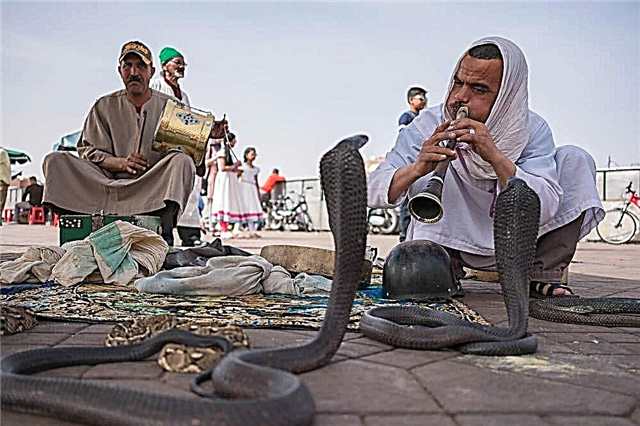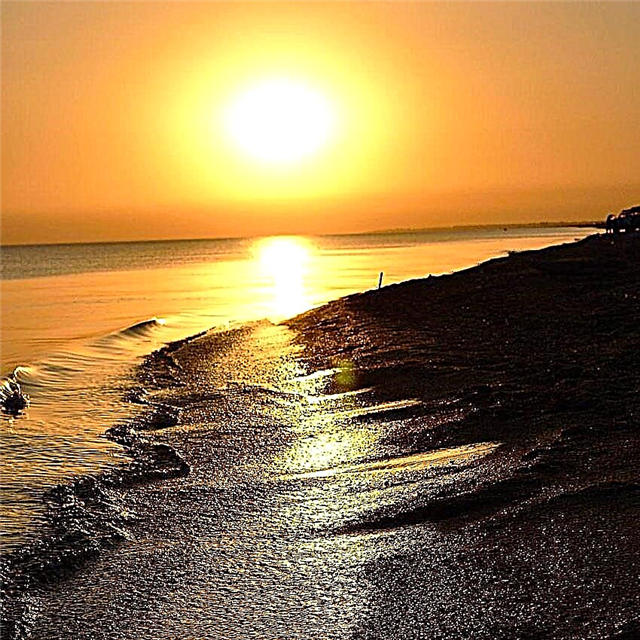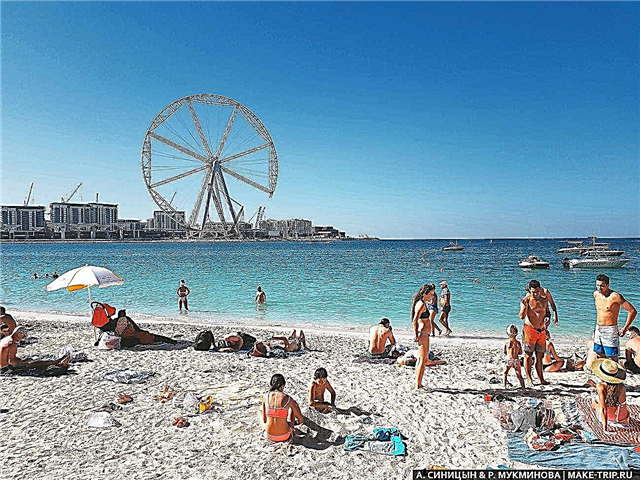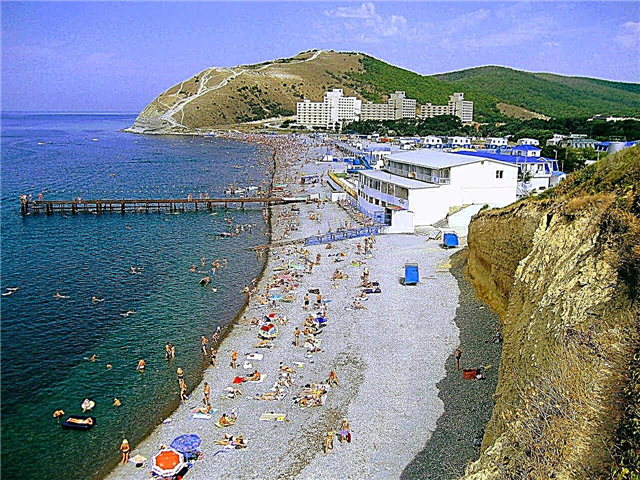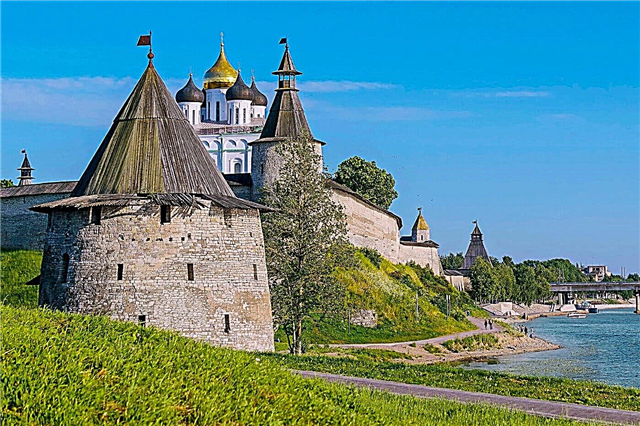Pskov is a wonderful example of Russian antiquity, which has preserved historical monuments and the atmosphere of a medieval city. Traditional acquaintance begins with the legendary Pskov Kremlin. The embankments of the Velikaya and Pskov rivers, on which there is a lot of interesting things, are obligatory for inspection. The city has preserved dozens of churches, the dates of their foundation date back to the 12th century, including UNESCO sites and unique representatives of the school of Pskov architecture.
The historical center of Pskov is simply replete with sights: houses of wealthy citizens, ancient chambers, museums and parks. It will take more than one day to see everything. Acquaintance with Pskov cannot be considered complete if you do not visit its surroundings: the holy places of the Pechersky Monastery, ancient Izborsk. Mikhailovskoye deserves special attention, it is worth coming here not only for admirers of Pushkin, but also for lovers of antiquity and protected nature.
The most interesting and beautiful places
List, photos with names and descriptions of the best sights of Pskov. He will help you plan routes to explore the top places of the city in 2-3 days.
Pskov Kremlin
The center of the ancient city is also called Krom, which means a secluded place where valuable reserves were stored. The snow-white fortress of the 11th-12th centuries rises on a cliff at the confluence of the Pskova River with the Velikaya River. The rivers enclose the territory on two sides, and the southern side is fenced off by a deep moat, Rowing, and also by a defensive rampart, which is called Percy. The main temple of Krom is the Trinity Cathedral. The central place is Vechevaya Square. The stone walls keep many secrets, and each of the towers has its own special history.

Read about all the top places in the region: the main attractions of the Pskov region.
Dovmont town
The ancient architectural complex bears the name of the Pskov prince Dovmont. It was built in the XII-XIII century to strengthen the southern side of the Kremlin, therefore Percy is also called the Dovmont Wall. The ruins of many ancient temples were found on the territory, the foundations were preserved. Fragments of wall paintings have been transferred to one of the Hermitage's repositories. The city was surrounded by a fortress wall, parts of which have survived. The central place is the Order Chambers of the 17th - 18th centuries.

Holy Trinity Cathedral
The main building of Krom, as well as the cathedral of the Pskov diocese. It was built in 1699, this is the fourth incarnation of the temple. Previous buildings were located at the same place. The five-domed building, 78 meters high, is clearly visible from different points of the city and its environs. It is interesting both the architectural solution and the interior decoration: the golden iconostasis, painted vaults. The relics of saints and miraculous icons are kept in the church.

Monument "Battle on the Ice"
Mount Sokolikha is located on the northern outskirts of Pskov. The troops of Alexander Nevsky passed by, heading for the Battle of the Ice. It was here in 1993 that a memorial monument was erected in honor of the victory of the Russian army. The mountain is not high, but it offers good views, you can see the outlines of the Kremlin and the Trinity Cathedral. The monument is a sculpture of a prince on a horse, surrounded by soldiers. Every year celebrations are held here on National Unity Day.

Embankment of the Velikaya River
The new embankment stretches along the famous river, at the foot of the fortress walls. From here Rurik went to Kiev, Princess Olga walked along these banks. The construction was completed in 2015, now there are wide sidewalks and benches. During the walk, you can see the fortress gates and towers nearby, from the pier you can take a boat trip along the river, sit in the shade of street cafes.

Pskova river embankments
The historical center of the city is decorated with picturesque embankments of the Pskova River. The most expensive houses in the city are located on the right bank, the facades of which are made in the style of the 19th century. This embankment is called Sovetskaya, but its unofficial name is Zolotaya. It starts from the Trinity Bridge and ends at the wall of the Okolny City. On the opposite bank there is an embankment along the fortress walls. There are observation platforms on both banks.

Order chambers
This part of Dovmont's town has been preserved in the best possible way. The building of the 17th century housed "tables", or city departments: court, money, local, discharge, ambassadorial. Since the 18th century, the building has housed armory chambers, in the 19th - shopping arcade, in the 20th - health and cultural institutions. The decoration of the facades and interiors has not survived, but is carefully recreated by archaeologists and architects.

Olginskaya chapel and observation deck
The modern religious building was erected on the site of a 19th century chapel that was lost during the Soviet era. The appearance of the new building is as close as possible to the historical description. Located on the banks of the Velikaya River, on the observation deck. At the heart of the building is an equilateral cross. The wall facing the temple is decorated with a bas-relief depicting Princess Olga. In the floor of the chapel there is a hatch for the descent to the source.
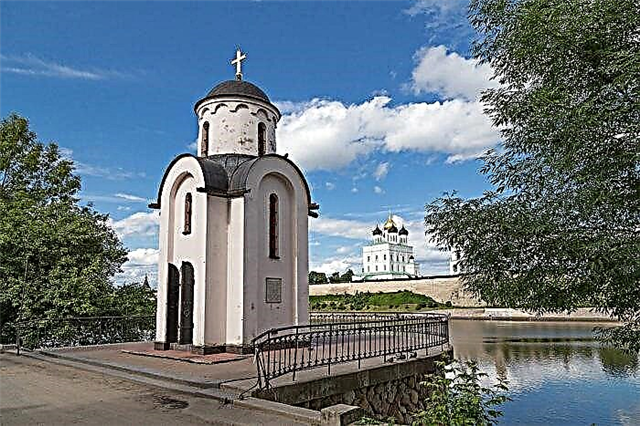
Pskov Forge Dvor
The museum complex was opened in 2008 in an old building near the Falcon Tower of the Roundabout City. Previously, the house of the priest was located here, and there was a church nearby. The museum consists of two smithies. The first contains archaeological finds, old blacksmiths, as well as real furs of the 19th century. The second smithy offers master classes where you can make your own souvenir. The place is popular not only among tourists, but also among representatives of creative professions.

Church of St. Alexander Nevsky
The large ancient temple on Zavelichye was built in 1906. This is a typical military church, consecrated in honor of one of the most revered saints of Pskov - Alexander Nevsky. The temple was abolished with the advent of Soviet power, but in 1992 services were resumed, a large-scale restoration was carried out. The church contains a piece of the relics of the holy prince, as well as other valuable relics. The building is a rare example of eclectic architecture.

Towers of the Pskov Fortress
Since the 13th century, the territory of the Pskov Fortress has expanded. New belts of fortifications appeared. Today you can see the preserved walls and towers of Krom, Dovmont, Sredny, Okolny gorod and Zapskovye.
Vlasyevskaya tower
The defensive tower served to protect the fortress wall from the side of the Velikaya River. The only gate leading to the center of Pskov, to the Old Market, passed through the tower. The customs office was also located here. The building has a high hipped roof and a viewing attic upstairs. The second largest tower of the Kremlin. It was originally rebuilt in the 15th century, but has been lost. In 1966, according to the historical description, the tower was recreated in the same place.

Kutecroma
The name of this tower can be interpreted as “the tower at the corner of the Kremlin”. She guards the northern corner of the fortress wall. It was originally built in 1400, but was badly damaged by the 19th century. Then there was a gazebo where A.S. liked to be. Pushkin. In 1961, the tower was restored and restored. It has five tiers, a wooden tent and an observation tower at the top. Height is about 30 meters.

Flat and High Towers at the Lower Lattices
The lower lattices are a structure above the water between two towers at the mouth of the Pskova River, a water-running gate. To protect the entrance to the river, at the beginning of the 16th century, two towers were erected on opposite banks. Flat is named so for its squat, low height. The tall tower is more slender and graceful, has a height of 8 meters, it was almost destroyed, it was rebuilt again in 1968. At the same time, the restoration of the Flat Tower was carried out.

Thunder tower
The tower of the early 16th century is considered the most picturesque and mysterious part of the Kremlin's defensive fortifications.It is located on Gremyachaya Mountain, but originally there was the Kosmodemyanskiy Monastery here, so the tower was also called Kosmodemyanskaya. It was built in 1525 to protect the entrance to the fortress from the Pskov side. Previously, there were Upper Lattices on the river, which blocked the waterway. The height of the six-tiered tower is 20 meters; 28 loopholes have been cut into the walls.

Pokrovskaya tower
The most powerful defensive fortification of an ancient fortress, and one of the largest towers in Europe. The base has a circumference of 90 meters, the height of the tower is 52 meters, including a wooden tent 19 meters. It was built in the late 15th - early 16th centuries, and was restored in 1968 and 2010. It is part of the Pokrovsky complex, together with the Pokrovsky gates and the church, as well as the Peter's bastions.

Monuments and monuments of Pskov
The city has many interesting historical and modern monuments and memorials that are worth seeing.
Monument to the Pskov paratroopers
The monument was erected in the village of Cheryokha, 10 km south of Pskov. It is dedicated to the memory of the 6th Airborne Company, which died in Chechnya in 2000. The monument is made in the form of an open snow-white parachute, under which a composition of 84 memorial candles is installed, according to the number of those killed. The pedestal represents the stylization of the mountain height on which the tragedy took place. It bears the names of the fighters awarded the Order of Courage, as well as 21 names of those awarded the Hero of Russia star.
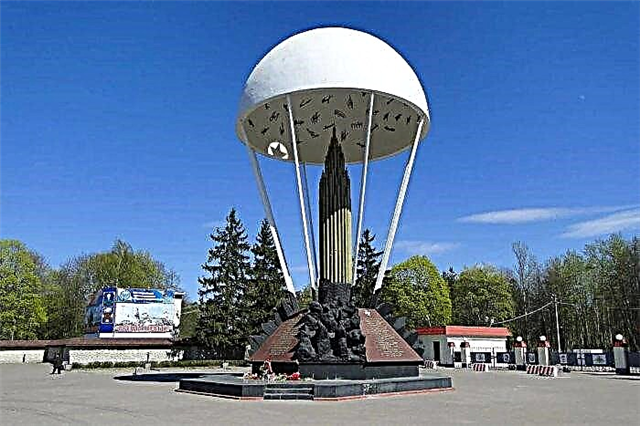
Monument to Princess Olga
The sculptural composition in the Children's Park was installed on the 1100th anniversary of the first mention of Pskov. The image of Princess Olga was not chosen by chance - it personifies spiritual continuity and strengthening of the Orthodox faith. Olga is depicted next to her grandson, Vladimir, who is destined to become a future baptist. Vladimir holds an icon in his hands. The high pedestal is decorated with bas-reliefs of the Pskov saints.

Monument to Pushkin and Arina Rodionovna
The name of the great poet is closely connected with the Pskov land. It was here, in Mikhailovsky, that the best works were written. The first monument to Pushkin was erected in the summer garden in 1983. The official name is poet and peasant, but people immediately called him "Pushkin and Nanny". A simple, modest woman sits next to the poet's sculpture, her face is calm, filled with wisdom, one can feel the support and strong connection between them.

Monument to the scraper
The small architectural form in the Pskov Kindergarten was a gift to the city on its 1111th anniversary. The monument depicts the image of a Pskov, a master of blacksmithing. He sits on a bench at work and holds out a horseshoe to a passer-by - a symbol of happiness and prosperity. The bronze sculpture is made in human height, tourists gladly rub, luckily, the horseshoe and nose of the brace, take pictures on his lap.

Interesting museums of Pskov
The city has a couple of fascinating museums, among others, worth visiting.
Kaverin Museum "Two Captains"
The museum of the famous writer was created on the initiative of the children's library, which was later named after him. The museum contains maps of the routes of Captain Tatarinov, Brusilov and Sedov, books and manuscripts of the author, tells the story of the exploration of the north. In the park in front of the library there is a monument to Ivan Tatarinov and Sana Grigoriev: purposeful, walking forward Grigoriev and sublime, soaring captain Tatarinov.

Pskov Railway Museum
The museum building is located on Vokzalnaya street, opposite the railway station. The exposition has been collected for many years, today it is a modern museum with interactive displays and high-tech equipment. Here you can get acquainted with the history of the Pskov railway workers, learn about their feat during the war, about the development of railways in the XX century. There are a lot of real exhibits, from tools of railway workers and the first tickets to whole carriages.

Main theaters of Pskov
The best theater and concert venues in the city.
Pskov Drama Theater named after A.S. Pushkin
The theater was built with public money, the collection was timed to coincide with the 100th anniversary of the poet, and the construction was completed in 1906. Until 1918, it was called the People's House, and the best pop singers and ballet dancers performed here. After the revolution, it was named the theater of drama. Since 2021, the theater has again become the People's House, international theater festivals are held here, the best artists perform.

Pskov Regional Philharmonic
One of the important centers of the city's cultural life. The founding of the Philharmonic was in 1944, and its development coincided with the restoration of Pskov after the military destruction. Today, interconnected music festivals are held here all year round, including the Pskov Symphony Orchestra. In addition to classical music, you can hear gusli and balalaikas, folk songs performed by a local ensemble.

Gardens and parks of Pskov
Nice green areas where you can take a leisurely walk, breathe fresh air and sit on a bench.
Mirozh arboretum
The arboretum was founded at the walls of the Mirozh monastery, the territory of a triangular shape was formed by the confluence of the Velikaya and Mirozha rivers. The first landings were made in 1966, and in 1967 the bridge of the 50th anniversary of October was opened. The very first landings have survived near the bridge. Recently, the park was reconstructed, paths, recreation areas were arranged, new plants were planted. One of the favorite places of the townspeople is a small duck pond.
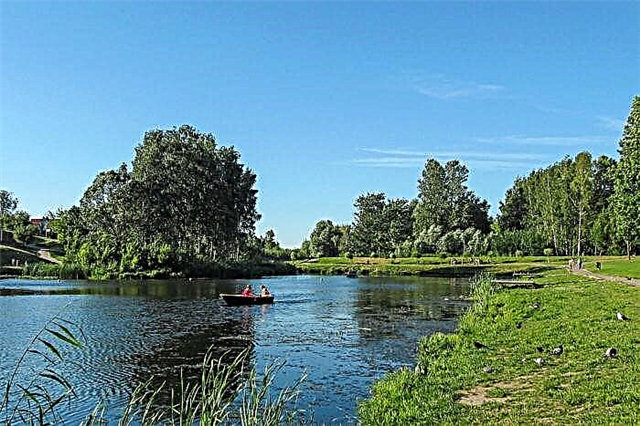
Finnish park Kuopio
The green area on the left bank of Pskov, not far from the historical center of the city, is called the twin city of Pskov, Kuopio. The park stretches for 600 meters from Kuznetsky to Troitsky bridge. In 1990, the territory was designed by Finnish specialists, and in 2015 the park was completely reconstructed. A network of paths, recreation areas, playgrounds has been arranged. It is worth noting historical sites: the ruins of a mill, fragments of fortress walls, foundations of churches.

Architectural landmarks of Pskov
The most famous and notable monuments of architecture and urban planning.
House of Soviets
An architectural monument of the 18th century in the classicism style. The building, built in 1786, has undergone numerous reconstructions; during its long history, it housed courts and military departments, a telegraph office and a cadet corps. Today it houses the Administration and the meeting of the deputies of the Pskov region. It is located in the city center, on Nekrasov Street. The place is closely connected with the founding of the Red Army and the development of Soviet power in Pskov.

Pogankin chambers
A monument of history and architecture of the 17th century, located at the corner of Museum (former Pogankin Lane) and Nekrasov Street. Historically, this area of the city was called Polonische. The building consists of three buildings, built of limestone slabs and whitewashed. The first owner is the merchant Sergei Ivanovich Pogankin. Currently, there are museum expositions dedicated to the painting of ancient Pskov and folk crafts, as well as the works of artists of the 18th - 20th centuries.

Menshikov Chambers
The chambers of one of the richest merchant families of Pskov, the Menshikovs, are located in the historic district of Okolny Gorod, on Romanov Gorka. Today this street is called Sovetskaya. The beginning of construction dates back to the 17th century, a total of four chambers were built, but they were badly damaged in a fire at the beginning of the 18th century. Currently, two buildings house expositions of the museum-reserve and the Pskov Potter factory, souvenir shops.

Masson's house
At the end of the 19th century, the house was built on the site of the former Zlatoust monastery, on the foundations of the church, the former burial vault of the Pogankin family. The first owner of the house is Ludwig Mason, a French teacher. After his death, the house was rebuilt in the Art Nouveau style, and with the advent of Soviet power, it was turned into a communal apartment. In 2005, the restoration of the building was completed, which became a museum. There are collections of precious metals and stones, ancient weapons, antique porcelain and glass.

The main monasteries of Pskov
Ancient Orthodox monasteries located within the city.On their territory there are also temples of church architecture of Pskov XII - early XVII centuries.
Mirozhsky monastery
A unique historical religious monument, known primarily for the preserved frescoes of the pre-Mongol period. The monastery complex is the Transfiguration Cathedral of the 12th century, fraternal and rector's buildings, fraternal cells, and Stefanovskaya church. It is not known exactly when the monastery was founded; historians call it the middle of the 12th century. Located on the spit of the Velikaya and Mirozha rivers, not far from Krom. The monastery has a church of St. Stephen, an icon painting workshop and an Orthodox museum.

Snetogorsk monastery
One of the most ancient Pskov monasteries is located in the bend of the Velikaya River, on a high bank called the Snapped Mountain. The foundation of the monastery dates back to the 13th century, initially it was a male monastery, now there is a functioning female monastery here. The main shrine is the Cathedral of the Nativity of the Virgin, built in 1311. It has preserved frescoes from the 14th century. The monastery complex also includes the Church of St. Nicholas the Wonderworker of the 16th century, the Bishops' House of the early 19th century, the Holy Gates and the fence.

Temples of the Pskov architectural school
A UNESCO World Heritage Site, the most significant historical temples and churches in Pskov.
Church of St. Nicholas from Usohi
The old church building is located on Sovetskaya Street, earlier this area was called Opoka. Initially, the church was erected here in 1371, next to a dried up swamp (from Usohi). The old building was destroyed and rebuilt in 1536. During the war, the church was badly damaged and was restored. The first service after an 80-year hiatus took place in 2008. The white-stone temple is a rare example of Pskov architecture.

Don't Miss: 30 Main Temples of Pskov
Basil's Church on Gorka
The only Pskov temple of the early 15th century is located in Sredny Gorod, on Vasilyevskaya Gorka, surrounded by the greenery of the Children's Park. The white-stone structure has the shape of a quadrangle, with two aisles. A characteristic feature of Pskov architecture is high arches and ornamental decor. In 2003, services were resumed in the temple, later new bells were installed. After restoration, the middle church is open to visitors.

Cathedral of John the Baptist
An ancient temple in Zavelichye, opposite Krom. It was founded as the main cathedral of the St. John the Baptist Monastery in the XII century, which has not survived today. Now it is the courtyard of the Krypetsky monastery. The white-stone building seems to be squat, since its lower part is 1.5 meters hidden by a cultural layer of earth. The design is very laconic, no frills, the building has irregularities in lines and proportions, characteristic of that time.

Church of Michael the Archangel from Gorodets
The first mention of this church dates back to the 14th century, and the buildings that have survived to this day - in the 15th - 18th centuries. The church was the center of the Gorodetsky end of Pskov, today Sovetskaya Street runs here. During its long history, the temple has undergone repeated restructuring. It is a low white stone building with a hipped bell tower. Currently, the temple has been restored, services are being held there, a Sunday school and a charitable canteen are operating.

Church of the Intercession and the Nativity from Prolom
A monument of history and architecture of the 15th - 16th centuries, was built at the site of the collapse of the fortress wall during the Livonian War, next to the Pokrovskaya Tower of the Kremlin. Consists of two churches sharing a common wall. The northern one is consecrated in honor of the Intercession, and the southern one - in honor of the Nativity of the Virgin. The limestone slab building has a laconic design, two chapters and a three-pillar belfry. In front of the church there are two ancient crosses, under one of them the defenders of Pskov are buried.

Church of Kozma and Damian from Primostia
There is no exact data on the date of foundation of this church, but historians attribute the architectural ensemble to the 15th - 16th centuries. Located at the intersection of Herzen and Leon Pozemsky Streets, this place was called the Zvannitsky Cross. The three-apse temple has two side-chapels and a free-standing belfry. The upper part of the belfry has not survived. The buildings are surrounded by a low fence with gates. Both external and internal decoration is very modest.

Church of St. George from Vzvoz
The church was founded in 1494. Has value as a historical monument of the times of the Pskov Republic. It is located on Georgievskaya Street, near the embankment of the Velikaya River. Unique tiles with ancient drawings have been preserved under the head of the temple. The four-pillar structure, characteristic of Pskov architecture, has interesting architectural features. The temple is open to visitors.

Church of the Epiphany from Zapskovye
The church is located in a very picturesque place, on the opposite bank of the Pskova River from the Gremyacha Tower. Its white walls and emerald roof rise among the green trees, a staircase descends from the church to a pedestrian bridge across the river, and a dam is built nearby. The three-domed temple has a high belfry with seven bells, the largest of which weighs two tons. Founded in the 15th century, it is considered one of the most perfect Pskov temples.
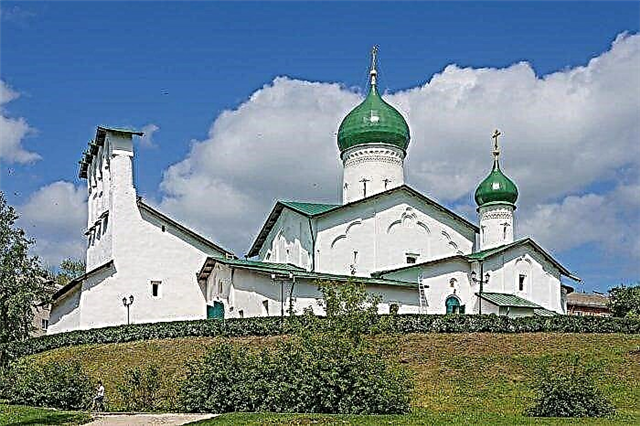
Attractions near Pskov
Interesting places in the vicinity of the city, where you can go by car.
Museum "Honey Farm"
You can study the history and interesting features of beekeeping in the Pechersk district of the Pskov region, 40 km from Pskov. The museum was founded by local beekeeper Gennady Glazov in 2002. The exposition consists of more than 10,000 exhibits, including many items of peasant life of the 19th - 20th centuries. Visitors can plunge into the profession of a carpenter, beekeeper and blacksmith, sit in a real master's chaise. The program includes exploring the exhibits in the fresh air and gatherings with tasting.

Izborsk fortress
The village of Izborsk is located 30 km from Pskov. An ancient fortress is very well preserved here, the foundation of which dates back to the XIV century. The whole village is designed as a large open-air museum complex, with stone-paved paths leading to the fortress. The architectural ensemble includes fortress walls, seven towers and two khaba. Tourists can climb the wall and the Lukovka tower. Inside the fortress there is the Nikolsky Cathedral.

Truvorovo settlement
Near Izborsk there is another ancient attraction - the remains of a settlement from the 7th - 18th centuries. It is located on a triangular plateau overlooking Lake Gorodishchenskoye. The first buildings are associated with the legendary Varangian Truvor, he is also credited with a grave at an ancient burial with the highest cross. The remains of dwellings, fortress walls, many household items were found. There is the Church of St. Nicholas the Wonderworker of the 17th century on the site

Pskov-Pechersky Monastery
One of the largest functioning monasteries in our country. It was founded in 1473, during its long history it has never been closed. The first church was dug in a sandstone mountain, now this place is called the Holy Mountain. The whole ensemble is very colorful and picturesque. In addition to the caves built by God, it includes 10 churches, the Rector's House, Holy Springs, the Belfry, and a fraternal complex. The monastery is surrounded by a fortress wall.

Talab Islands and Pskov Lake
Lake Pskov is the southern part of the Peipsi-Pskov lake complex, located 25 km north-west of Pskov. Has an area of over 700 km2... In the southeastern part of the lake there is a group of three islands, their second name is the Zalitsky Islands. There have been settlements here for a long time, today less than 200 people live on the islands. On the island of Talabsk, there is the Church of St. Nicholas, where the revered elder Nikolai Guryanov is buried.

Museum-reserve "Mikhailovskoe"
In the Pushkinogorsk district of the Pskov region, 115 km from Pskov, there is the family estate of the mother of A.S. Pushkin. The poet's house and estate have been recreated here, and his grave is located. The museum-reserve also includes the Trigorskoye and Petrovskoye estates, the Holy Dormition Monastery with the Hannibal-Pushkin necropolis.On the territory of 9713 hectares there are ancient settlements, reserved lakes and meadows, estates of neighbors and friends of the poet.




